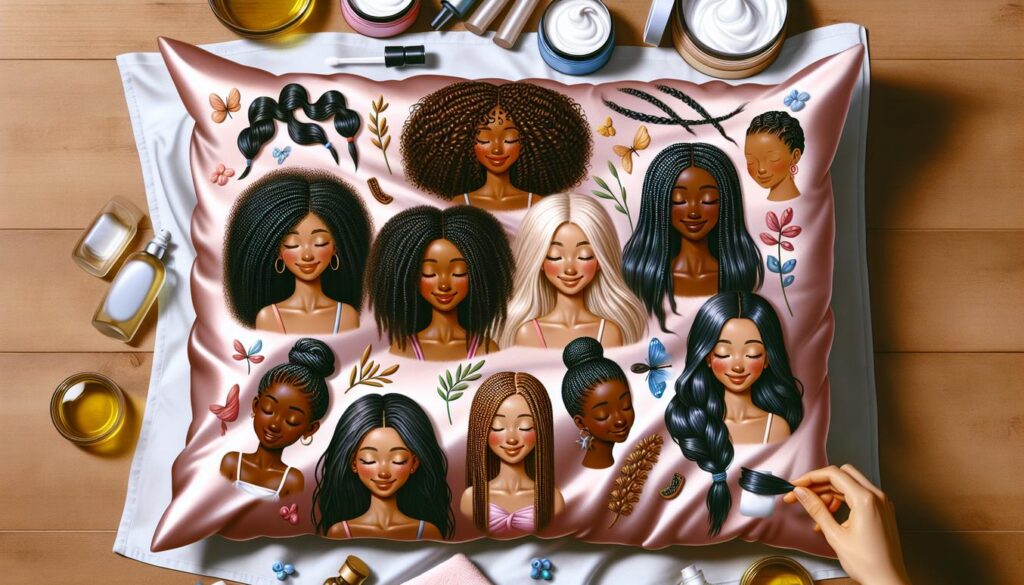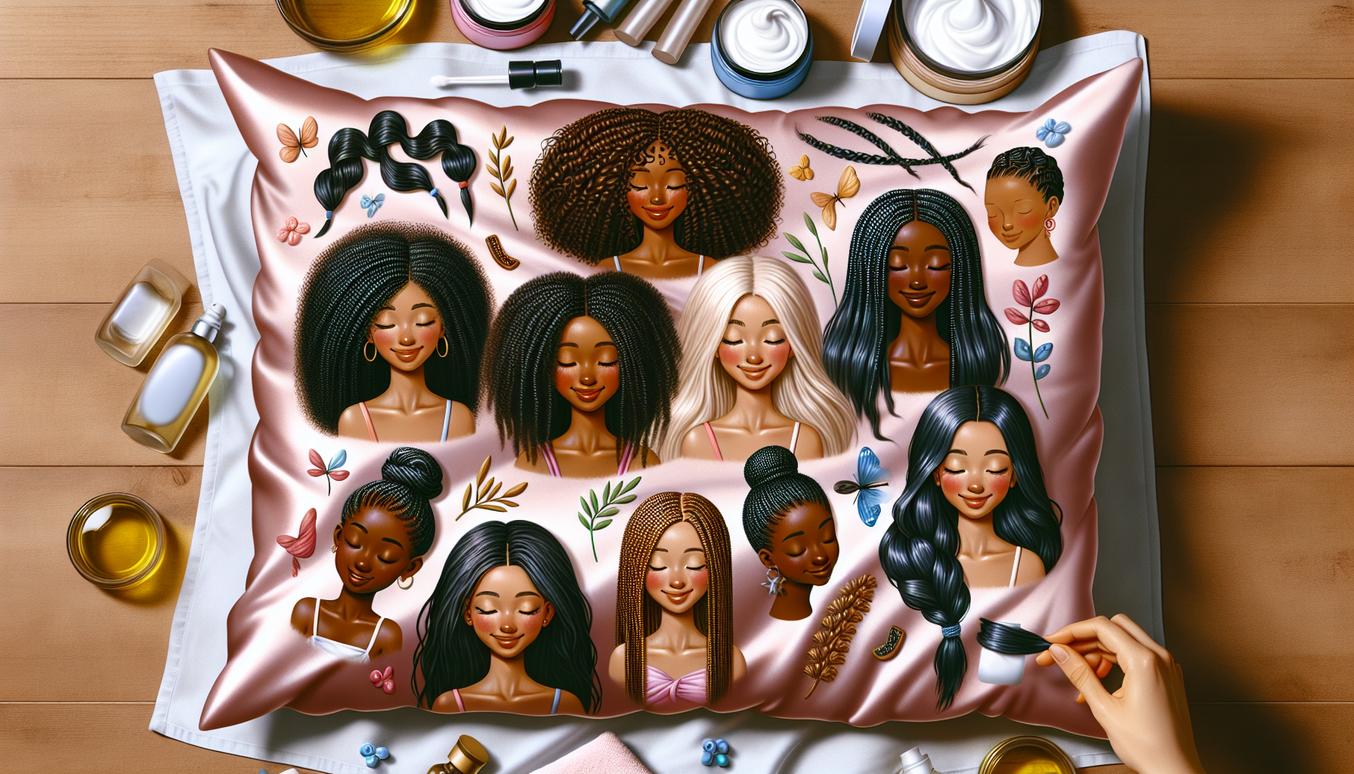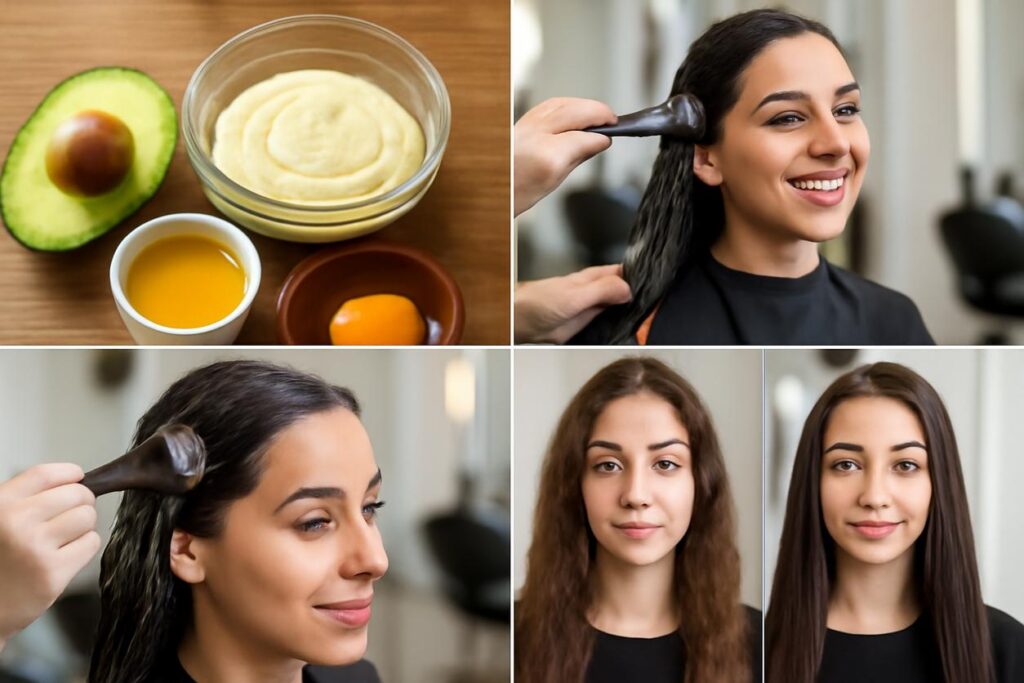Why Nighttime Hair Care Matters
You spend a third of your life sleeping, but have you ever considered what that time does to your hair? Tossing and turning on a standard cotton pillowcase creates friction, leading to frizz, tangles, and even breakage. This is where a dedicated overnight hair care routine becomes a game-changer. It’s not about adding complex steps to your already busy day; it’s about making small, strategic adjustments before bed that protect your strands while you rest.
Think of it as passive hair improvement. While you sleep, your body is in repair mode, and your hair can be too. An effective overnight hair care strategy helps to lock in moisture, prevent physical damage, and reduce the time you spend styling in the morning. Instead of waking up to “bed head,” you can wake up with hair that is smoother, more manageable, and healthier in the long run. For a foundational understanding of hair health, general advice from sources like the NHS on hair care provides a great starting point.
Identify Your Hair Texture and Main Concerns
The first step in any successful hair care journey is understanding what you’re working with. A one-size-fits-all approach doesn’t work because different hair textures have unique needs. Identifying your type is key to an effective overnight hair care plan.
Hair Texture Basics
Hair is generally categorized into four main types:
- Type 1: Straight Hair – Lacks a natural curl pattern. Tends to get oily faster than other types because scalp oils travel down the shaft easily.
- Type 2: Wavy Hair – Forms a gentle ‘S’ shape. Can be prone to frizz and may be fine, medium, or coarse.
- Type 3: Curly Hair – Forms defined ringlets or spirals. This type is often prone to dryness and frizz because the shape makes it harder for natural oils to moisturize the ends.
- Type 4: Coily Hair – Features tight, Z-shaped coils or springs. This is the most fragile hair type and requires significant moisture to prevent dryness and breakage.
Common Concerns by Texture
Your nighttime routine should address your primary hair concerns. Here’s a quick guide:
| Hair Texture | Common Concerns | Overnight Goal |
|---|---|---|
| Straight | Oiliness, lack of volume, tangles | Preserve volume, prevent tangles, manage oil |
| Wavy | Frizz, undefined waves, dryness | Enhance wave pattern, control frizz, add moisture |
| Curly | Dryness, frizz, loss of curl definition, breakage | Preserve curl clumps, deeply moisturize, reduce friction |
| Coily | Extreme dryness, shrinkage, breakage, tangles | Maximize moisture retention, stretch coils, prevent breakage |
Evening Prep: Cleanse, Co-Wash or Refresh
Your overnight hair care begins with the state of your hair before your head even hits the pillow. It’s crucial to start with a clean or properly prepped base.
When to Wash Before Bed
Going to bed with wet hair can be damaging. Hair is at its most fragile when wet, and the combination of moisture and friction against a pillow can lead to breakage. If you must wash your hair in the evening, try to do it a few hours before bed. Allow it to air dry at least 80% of the way or use a diffuser on a low-heat setting. This minimizes the risk of mechanical damage and potential scalp issues.
Co-washing vs. Refreshing
For those with curly and coily hair, washing daily is often not an option. Instead, you can either co-wash or refresh.
- Co-washing: This involves washing your hair only with conditioner. It’s a gentle way to cleanse without stripping natural oils, making it ideal for dry, textured hair.
- Refreshing: This is a non-wash day technique. Lightly mist your hair with water or a leave-in conditioner spray to reactivate products from the previous day. You can then re-apply a small amount of cream or gel to redefine your texture before putting it in a protective style for the night.
Nighttime Nourishment: Oils, Masks and Leave-Ons
The uninterrupted hours of sleep provide the perfect opportunity for deep conditioning and nourishment. Your hair can absorb treatments without being exposed to environmental stressors like sun and wind.
The Role of Leave-in Conditioners
A leave-in conditioner is a lightweight first step for almost every hair type. It provides a layer of moisture and slip, making hair easier to detangle and manage. For finer hair, a light spray is sufficient. For thicker, coarser hair, a cream-based leave-in can provide more substantial hydration.
Sealing with Oils
After applying a water-based leave-in, using a small amount of a lightweight oil (like argan, jojoba, or grapeseed oil) can help seal in the moisture. This is particularly beneficial for wavy, curly, and coily hair types who struggle with dryness. This technique, often part of the LOC (Leave-in, Oil, Cream) method, ensures hydration is locked into the hair shaft overnight.
Deep Conditioning with Overnight Masks
An occasional overnight mask can work wonders for dry or damaged hair. Apply a deep conditioning mask to your hair, cover it with a shower cap or bonnet to trap heat and prevent mess, and then rinse it out in the morning. This intensive form of overnight hair care delivers a powerful dose of moisture and nutrients.
Protective Night Styles by Texture
How you wear your hair to bed is one of the most critical aspects of overnight hair care. The goal is to minimize friction and prevent tangles. Always use gentle hair ties like scrunchies or spiral hair ties, never tight elastics.
For Straight Hair
To avoid tangles and kinks, a loose braid is ideal. It keeps the hair contained without creating a strong wave pattern. Alternatively, you can twist your hair into a loose, high bun on top of your head using a soft scrunchie.
For Wavy Hair
To protect and enhance your wave pattern, try the “pineapple” method. Gather your hair into a very high, loose ponytail on top of your head. This protects the waves from being crushed while you sleep. A loose braid or two can also work well.
For Curly Hair
The pineapple method is also a favorite for curly hair. For added protection and moisture retention, sleep with your hair covered in a satin-lined bonnet or scarf. Multi-mini-pineapples or two-strand twists can also help preserve curl clumps.
For Coily Hair
Moisture retention and preventing shrinkage are key. Styles like two-strand twists, braids, or the banding method (using hair ties down the length of a ponytail to gently stretch it) are excellent. Always cover your hair with a bonnet or scarf to protect your fragile ends.
Pillowcase and Sleep Environment Tips
Your sleep environment plays a huge role in your hair’s health. Cotton is highly absorbent and can sap moisture from your hair shaft, leaving it dry and brittle. Its rougher texture also snags hair cuticles.
The solution is to reduce friction. You can achieve this in two primary ways:
- Switch Your Pillowcase: Invest in a silk or satin pillowcase. These materials have more “slip,” allowing your hair to glide over the surface with minimal friction. This reduces tangles, frizz, and breakage.
- Wear a Head Covering: A satin-lined bonnet, scarf, or sleep cap provides a protective barrier between your hair and the pillowcase. This is an essential practice for preserving curly and coily styles and is a cornerstone of effective overnight hair care.
How Often to Use Intensive Overnight Treatments
While daily nighttime prep is important, intensive treatments should be used more sparingly. The right frequency depends on your hair’s condition.
- For High Porosity or Damaged Hair: You may benefit from an intensive overnight mask once a week.
- For Normal to Low Porosity Hair: Once every two to four weeks is generally sufficient to provide a boost of hydration without causing product build-up or over-moisturizing your hair.
Always listen to your hair. If it feels mushy or overly soft, you may be over-conditioning. If it feels dry and brittle, it might be time for a treatment.
Quick 10-Minute Routines for Busy Evenings
Don’t have time for a full routine? A simplified overnight hair care plan is better than nothing. Here’s a 10-minute plan for those busy nights:
- (3 minutes) Detangle: Gently brush or comb your hair, starting from the ends and working your way up to the roots.
- (2 minutes) Moisturize: Apply a small amount of leave-in conditioner or a few drops of oil, focusing on the ends.
- (3 minutes) Style: Put your hair into a quick protective style suitable for your texture (e.g., a loose braid or pineapple).
- (2 minutes) Protect: Swap to your satin pillowcase or pop on your bonnet or scarf.
DIY Overnight Masks with Pantry Ingredients
You can create effective overnight masks using ingredients from your kitchen. Always perform a patch test on your skin before applying a new mixture to your hair and scalp.
- For Moisture (All Hair Types): Mix two tablespoons of aloe vera gel with one tablespoon of coconut oil. Aloe is hydrating, and coconut oil helps lock in moisture. Apply to hair, avoiding the roots if you have oily hair.
- For Strength (Damaged Hair): Whisk one egg yolk with two tablespoons of olive oil and one teaspoon of honey. The protein in the egg can help strengthen the hair shaft, while olive oil and honey add moisture and shine. Use this treatment sparingly to avoid protein overload.
Remember to cover your hair with a shower cap to protect your bedding.
Common Mistakes That Cause Morning Breakage
Are you waking up with more frizz and tangles than you went to bed with? You might be making one of these common mistakes:
- Sleeping on Wet Hair: As mentioned, hair is extremely fragile when wet.
- Using Tight Hair Ties: Metal clasps and tight elastics can snag and break strands. Opt for soft scrunchies or fabric ties.
- Skipping Detangling: Going to bed with existing tangles will only make them worse overnight.
- Sleeping on a Cotton Pillowcase: The friction is a primary cause of morning frizz and breakage.
- Applying Too Much Product: This can lead to build-up, weighing your hair down and making it look greasy.
Choosing Ingredients to Avoid and to Seek Out
The products you use in your overnight hair care routine matter. Reading ingredient labels can help you make informed choices. The scientific community is constantly exploring how different ingredients interact with hair, and resources like PubMed house extensive research on the topic.
Ingredients to Seek in 2025 and Beyond
- Hyaluronic Acid: A powerful humectant that draws moisture from the air into your hair.
- Glycerin: Another effective humectant that helps hair retain moisture.
- Keratin and Silk Amino Acids: Proteins that help to fortify and repair the hair shaft.
- Natural Oils and Butters: Ingredients like argan oil, shea butter, and jojoba oil are excellent for sealing in moisture and providing nutrients.
Ingredients to Avoid
- Drying Alcohols: Short-chain alcohols like alcohol denat, isopropyl alcohol, and propanol can be drying when used in high concentrations in leave-on products.
- Heavy Silicones: While some silicones can be beneficial, heavy, non-water-soluble ones can build up over time, requiring harsh shampoos to remove.
- Mineral Oil and Petrolatum: These can create a heavy film on the hair, preventing moisture from penetrating the shaft.
Step-by-Step Sample Routines by Hair Type
Here’s how to put it all together. This is your texture-specific guide to overnight hair care.
| Hair Type | Step-by-Step Routine |
|---|---|
| Straight | 1. Gently brush to detangle and distribute natural oils. 2. Apply a few drops of a very lightweight oil to the ends if they are dry. 3. Loosely braid hair or secure in a high bun with a silk scrunchie. 4. Sleep on a silk or satin pillowcase. |
| Wavy | 1. Lightly mist hair with water or a leave-in spray to refresh waves. 2. Scrunch a small amount of curl cream into the hair if needed. 3. Gather hair into a high, loose “pineapple” with a scrunchie. 4. Sleep on a silk pillowcase or wear a bonnet. |
| Curly | 1. Section hair. Apply leave-in conditioner and a curl cream to each section. 2. Seal the ends with a lightweight oil. 3. Put hair in a “pineapple” or create 2-4 loose two-strand twists. 4. Cover with a satin bonnet or scarf. |
| Coily | 1. Apply a generous amount of a rich leave-in conditioner or moisturizing cream. 2. Seal thoroughly with a heavier oil or butter (e.g., shea butter). 3. Style in braids, twists, or use the banding method to stretch coils. 4. Always cover with a satin-lined bonnet or cap. |
Frequently Asked Questions About Overnight Care
Is overnight hair care necessary for everyone?
While not strictly “necessary,” almost everyone can benefit from a basic nighttime routine. At a minimum, sleeping on a satin pillowcase or loosely tying up long hair can significantly reduce morning tangles and frizz, regardless of hair type. The intensity of your routine should match your hair’s needs.
Can I leave any conditioner in my hair overnight?
No, you should only use products specifically designed to be left in overnight. Regular rinse-out conditioners can lead to over-moisturization (hygral fatigue) and build-up if not washed out. Stick to designated leave-in conditioners, oils, and overnight masks.
Will my hair get greasy from using products at night?
If you’re using the right products for your hair type and applying them correctly, your hair shouldn’t get greasy. Focus application on the mid-lengths and ends, avoiding the scalp. If you have fine or oily hair, use lightweight sprays and oils sparingly.
Morning Follow-Up: Gentle Wake-Up Steps
Your morning routine is just as important as your overnight hair care. How you “wake up” your hair sets the stage for the rest of the day.
- Gently Take Down Your Style: Unravel your braids, twists, or bun carefully. Don’t pull or rip through any tangles.
- Shake and Fluff: For textured hair, gently shake your head from side to side to loosen the roots and let your hair settle. Use your fingers or a hair pick to fluff and style, but avoid over-touching, which can create frizz.
- Refresh as Needed: Straight hair might just need a quick brush. Wavy and curly hair may benefit from a light mist of water or a refreshing spray to bring back definition. A small amount of oil can be used to tame any remaining frizz.
Summary and Practical Checklist
Embracing a consistent overnight hair care routine is a simple yet powerful way to improve your hair’s health, appearance, and manageability. By protecting your hair from friction and providing it with nourishment while you sleep, you’re investing in healthier strands for the future.
Your Nightly Hair Care Checklist:
- [ ] Assess: Is my hair dry, damp, or wet? (Aim for dry or mostly dry).
- [ ] Detangle: Gently remove all knots and tangles.
- [ ] Nourish: Apply a leave-in, oil, or cream appropriate for your hair type, focusing on the ends.
- [ ] Style: Secure hair in a loose, protective style (braid, bun, twists, pineapple).
- [ ] Protect: Use a silk/satin pillowcase, bonnet, or scarf.
By following these steps and tailoring them to your unique hair texture, you can transform your sleep into a restorative beauty treatment, ensuring you wake up with hair that’s ready to face the day. Reputable sources like Rich Hair UK offer further insights into texture-specific care and best practices.





